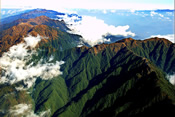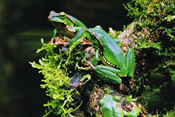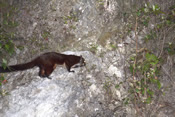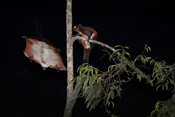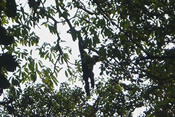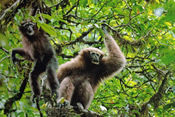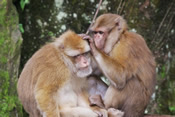
 |
| Take a closer look at the hoolock gibbon. (From Seven Years in Nankang, By Li Jiahong) |
By Milo Whittle, 10-year-old
|
Editor’s Note: The southern section of Gaoligongshan Nature Reserve is located at the intersection of Baoshan Prefecture's Longyang District and Tengchong County in western Yunnan. Renowned for its rich biodiversity, some 4,897 species of higher plants and numerous rare animals, including 81 first- and second-class state-protected species, have been recorded in the reserve. Since 2007, PCD has been helping activities to conserve the biodiversity of this section of the reserve. By supporting surveys on the traditional culture of the local communities, we explore non-economic incentives in nature conservation. Concrete activities include nature experiential learning and exploration on nature education curricula that are appropriate to the local culture and environment. For example, in accordance with the local tradition of protecting small egrets, villagers have been encouraged to get involved in observing the life and habits of birds and participate in the protection of their chicks. Activities to enable villagers to gain knowledge about biodiversity and traditional plants have been organised. We have been promoting ecological agriculture, educating villagers about the hazards of pesticides and chemical fertilisers and the value of farming. Other activities focus on protecting ancient trees and headwater forests as well as observing and conserving Chinese bees and the environment. PCD has also been supporting efforts to build a community-based biodiversity volunteers’ network. Local communities have been conserving nature from the perspective of their traditional culture. What is biodiversity conservation in the eyes of children? Ten-year-old Milo Whittle is the nephew of Andrew McAulay, Chairperson of the PCD Management Committee. In April this year, he joined his uncle on a visit to Gaoligongshan Nature Reserve and had an opportunity to follow and watch interesting forest animals in the reserve at night. His eager anticipation and pleasant surprise when he suddenly encountered the animals is a manifestation of the joy that nature can bring to human beings. Below is Milo’s depiction of his happy adventure to track and watch flying squirrels, tree frogs and hoolock gibbons. |
On Day 5 of our trip, we went on an animal safari at 10:00 pm, looking for red flying squirrels and tree frogs in a moon bear-infested forest. Cool eh? But...... a little scary, I have to say. We walked through the forest with no luck, so we eventually had to turn back because we were getting really deep in the forest where most of the moon bears roam.
Tons of Frogs
On our way back we spotted a pond so we looked to see if there were any tree frogs there. We looked and looked and looked … and found tons! All of them were making loud croaking noises. There was one that was so close to us it was just staring straight up at me, so I got some really good photos.
We walked all the way back to the nature reserve thinking that we would never see a red flying squirrel. But the phone was ringing. One of the nature reserve people picked it up and smiled. She said in Chinese, "ta men kan dao le!" which means: they found it! So we quickly jumped in the car and drove to where the other group of people said they'd seen one. In the car I was chit-chatting to myself because I was so excited. Once we got there we looked around and saw a pair of glowing eyes in the trees. I shone my torch on the tree and saw it. It was much bigger than I thought! A red flying squirrel has yellow glowing eyes. So then we waited some more and saw two red flying squirrels in the tree, then three, then four!
They Really Fly!
But guess what the best thing about the squirrel is? It actually flies! So we waited to see it fly from one tree to another. Finally, one spread its 'wings' really wide and flew about twenty metres onto the little hill next to the road. When he got there he started looking in the rocks for salt to eat. We hurried over to him so we could get close up and see him more clearly. When I got there I was about one or two metres away from him. I got some really good pictures. And just then another flew out of the tree into another tree in the forest, and as we were looking at that one, another came flying out from the tree to the same place as the one on the hill next to the road. Then while we were looking at that another one flew into the same place so that we could see three on the same little hill. In the end we saw five red flying squirrels, and four actually flying! The nature reserve guy said we were the luckiest people who had ever seen the red flying squirrels, and the luckiest people to get so close. I found it very interesting that the red flying squirrels were not scared of the trucks on the road.
The next morning I got woken up by a very eager Maggie [a PCD staff member]. She burst into our room like a riot screaming (I'm exaggerating): "They have called and said they have seen the Hhoolloocckk Giibbbboonn!!" I quickly jumped out of bed and got my clothes on, grabbed some breakfast and then was ready to go.
We walked along a forest trail for a bit with our nature reserve guide, then he took a sharp right into the depths of the jungle. In the forest it was a very steep downhill slope so I tripped about ten times and planted my face on the ground. After 20-30 minutes of face-planting we heard a noise: WUA WUAHAHOHOOHAWOO which is kind of hard to express in writing. We rummaged around in the spiky bamboo until... BOOM! We bumped into the other group (not what you were expecting eh?) but we could still hear the WUA WUAHAHOHOOHAWOO sound. But when I saw the group's smiley faces, that's when I slowly slowly lifted my head and right on the branch of the tree was...... Nothing. ONE WORD: SAD.
Who Screamed?
But then when I looked up to the other branch I saw something that looked like a big brown football with furry arms and legs. Wait....? Is that a big brown football with furry arms and legs? NO!!! Then at that moment somebody screamed: "Iiiiitttt'sss aaaaa Hhhooolloooccckkk Giibbbooonnn!" I thought to myself: who just screamed "it's a hoolock gibbon" in a voice like you just became the president of America and in your welcome speech you just noticed that all you're wearing is a pair of knickers with red hearts on it. Then..... I noticed the person who just screamed.... was me. Anyway, after screaming like a lunatic x1000, what do I do next?
I slowly put my hand into my pocket and without taking my eyes off the gibbons, I took my camera out, pressed the ON button and then pressed the VIDEO button in a very professional way; and then got my lens fixed on the APE and got a great video which is on my camera, not on this iPad.
Anyway, after I did all the filming and all that bla bla stuff, that's when I heard something like a pig’s oink but only lower and more like a gluteus maximus (scientific word for you know what) getting stepped on. I asked the guide what it was and he said it was a bear. I shouted: "A BEAR!" The guide said: not a bear, a bear monkey. I said: "Oh." Then we walked back to the nature reserve saying, "Mission accomplished."


